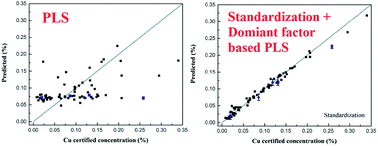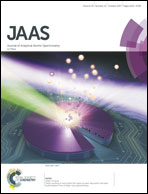Quantitative analysis of common elements in steel using a handheld μ-LIBS instrument†
Abstract
Laser-induced breakdown spectroscopy (LIBS) was named a future superstar. Nevertheless, in the last couple of years, several commercial instruments of LIBS and its different variants have become available on a limited scale due to the confinement of quantitative analysis. In this paper, quantitative analysis of various steel samples using a specially designed handheld μ-LIBS instrument and dominant factor based partial-least squares (PLS) regression with spectral standardization is presented. Average absolute measurement errors of 0.019, 0.039, 0.013 and 0.001% for the elements of Si, Cr, Mn and Ni, respectively, were achieved. The average relative standard deviation (RSD) for these elements was less than 5%. A linear calibration response was obtained for C which is difficult to achieve using traditional PLS and for Cu whose concentration in the samples is very low. The results are better than the results of previous LIBS studies using μJ lasers or portable handheld devices, comparable to those obtained using conventional benchtop LIBS systems and better than those of commercial handheld XRF instruments. The present work presents the best results for steel analysis using portable LIBS systems so far and shows the feasibility of the technology for real industrial applications.



 Please wait while we load your content...
Please wait while we load your content...